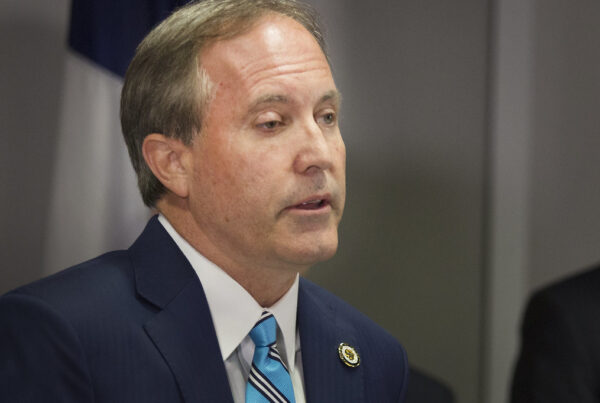The Muleshoe National Wildlife refuge spreads over nearly 7,000 acres in the western part of the Texas Panhandle.
It’s a bit of an oasis in the sprawling grasslands that surround it. Three lakes on the property provide a respite for migrating birds like sandhill cranes and pintail ducks. It’s also home to animals such as prairie dogs and Texas horned lizards.
It’s an important area for conservation, and soon, it might get much bigger. The U.S. Fish and Wildlife Service plans to expand the Muleshoe refuge by more than ten times its current size. But not everyone is thrilled with the idea.
Brandi Addison is a Texas-based reporter for the USA Today Network. She spoke to Texas Standard about the potential expansion. Listen to the interview above or read the transcript below.
This transcript has been edited lightly for clarity:
Texas Standard: It seems like a rather significant expansion of this wildlife refuge – tenfold. What’s the Fish and Wildlife Service’s goal behind this growth?
Brandi Addison: So like you said, the goal is to expand it. They’re hoping up to 700,000 acres of expansion. And it’s a completely voluntary program.
So, of course, as you mentioned, the idea is just to restore this native habitat for really crucial species – including some that are have reached a point of no return, like the lesser prairie chicken. And this habitat has been damaged for a number of reasons over the last few decades. And now they’re just trying to bring that habitat back.
So, this falls under the America the Beautiful initiative. It’s a $1 billion initiative that aims to accelerate conservation efforts across the U.S., and they seek to restore at least 30% of U.S. lands and waters by 2030.
When they say “restore,” you mean because they’ve eroded, they’ve been taken away, or what?
So Muleshoe is in West Texas and, as we know, West Texas is the biggest agricultural region in the U.S. It’s also prone to some energy development, right? So, yeah, there’s been a lot of habitat fragmentation going on over here.
So I think that’s what a lot of the effort is, is to restore some of these lands that have been taken and maybe not properly taken care of or managed and just kind of bring their native habitat back.
» GET MORE NEWS FROM AROUND THE STATE: Sign up for Texas Standard’s weekly newsletters
I want to tap into something you were saying earlier about this being voluntary. I know that this refuge is surrounded by private property – we’re talking mostly farms and ranches. So how is the Fish and Wildlife Service hoping to acquire this land, or have they acquired it already?
So this is, like I said – and I’m going to continue to say this – totally voluntary in the sense that they are basically acquiring land from private landowners through fee title acquisitions, which is basically the outright sale of land, right? And once purchased by the Fish and Wildlife Service, it is part of the protected wildlife habitat managed by that refuge. It is no longer under the ownership of those former owners.
They’re doing another way as well, which is easement acquisitions. And so this is basically giving Fish and Wildlife Service certain rights to this land, such as the right to restrict development, but the landowners still retain this ownership, and the Fish and Wildlife Service is willing to pay up to 60% of that property value. So at the end of the day, they still retain ownership, but they can’t bring new development onto that property.
Usage rights is what we’re talking about there. But at the same time, as I was mentioning, not everyone’s a big fan of this idea. Who’s driving the criticism and what’s their argument?
So there is a property rights organization called American Stewards of Liberty, and they have actually on their website a section called “Muleshoe Land Grab.” I will note that there has been some confusion as a result of their website because they said that it was going to be 7 million acres, which is larger than eight states if you go up north. So that’s not necessarily accurate. It’s actually 700,000.
And their biggest argument is really just that once they grant these conservation easements or whatever, that there will be continued regulatory pressure from the government. So regardless of it being voluntary, they’re concerned that it’s going to worsen and that there will be additional restrictions that eventually the government will impose.
So a slippery slope argument is what they seem to be saying.
And then we have Rep. Jodey Arrington out here who is very much against this. And he did say verbatim that he does not believe it’s a good use of taxpayer dollars, but he also, in a news release, said there’s “no such thing as a voluntary government program.”
Is there eminent domain planned for any of this property?
Absolutely not. There is no eminent domain involved whatsoever.
Is this plan now past the point of no return? Has it been published in the Federal Register and everything, or could it still be changed or potentially even scrapped?
I’m not sure if it’s been through the Federal Register or not yet. They did finalize this back in June 2023, and the biggest argument, again, that I’m hearing from critics is that they actually never got Congress involved or anyone else involved – like this was just something that happened and then it went live to the public in April 2024.
So it was coming as a result of something that the U.S. Fish and Wildlife Service is doing unilaterally, you’re saying.
Right. This has been something that they’ve been seeking out for a while now. And previously or prior to this plan right here, they wouldn’t even allow people to donate that land because there was not, like, set boundaries. I believe there was not like a set boundary plan. So this comes as part of that plan.
What are you hearing about next steps? Is this already happening? Are people already selling off easements or what?
I have not heard about whether people are selling easements or not.
I will admit that we are in West Texas, so people are especially wary when it comes to their property, you know, for understandable reasons. Like this is a lot of people’s livelihoods on the line when it comes to agriculture and energy and ranching, and I totally respect that. And I totally understand the perspective of those people who don’t want to have more government involved.
But at the same time, I again want to recognize that, one: this is totally voluntary. Two: we’re at this point that we need to do this because of the habitat fragmentation and there’s really not a lot of opportunity in Texas because, as you know, Texas is 98% private.














